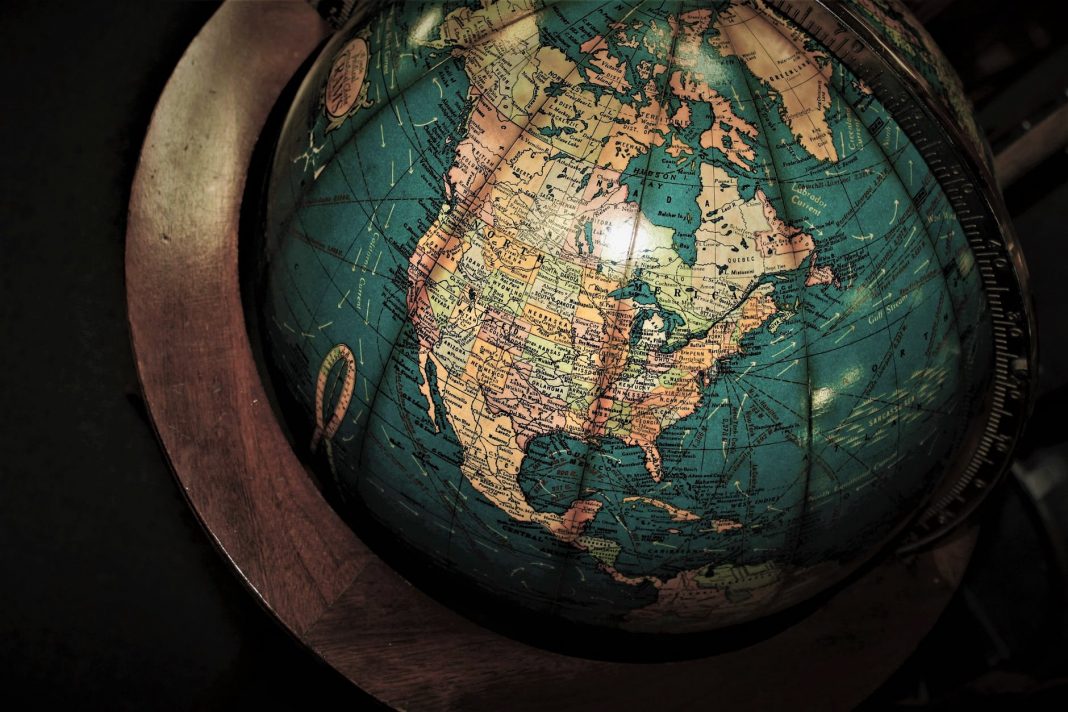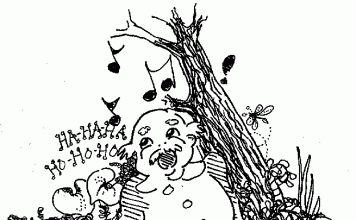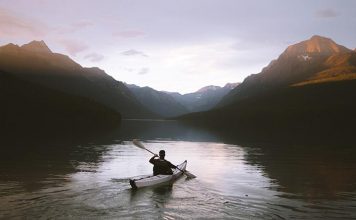 |
|
| Issue #57 • May/June, 1999 |
We were preparing the current issue and the office hummed as it always does during deadline. Dave Duffy, the fellow who publishes this magazine, explained to our new artist what he wanted in a drawing; Mark Cogan, the fellow who does layout and has been changing the look of the magazine, was setting the cover; I was reading yet another submission fraught with predictions of dire catastrophes that lay in wait for us.
Off in the corner sat O.E. MacDougal, hunter, fisher, and poker player extraordinaire, looking like a bum in his tattered jeans and sweatshirt with his feet propped up on a desk as he disassembled a fishing reel he’d picked up at a local garage sale. He’d come up from southern California for another visit and to do some fishing before the steelhead run ended.
I don’t know what to make of the doom and gloom scenarios that come in the mail from various writers. I’m not sure I’m really qualified to evaluate them. I was reading one such article and stopped for a few moments to watch Mac fiddle with the gears inside the reel.
Y2K
Suddenly I asked, “Mac, what do you think of this Y2K thing?”
He looked at me curiously and I realized I hadn’t asked the question right.
“What kind of effects do you think it’s going to have?” I asked.
“It’s already having effects. People are rewriting and redesigning software, replacing computer chips…”
“I mean, do you expect it to be a disaster or, as some people put it, do you expect it to bring about ‘the end of the world as we know it?'”
He shook his head. “I think it’s a tempest in a teapot. I don’t think most people are going to have their lives seriously disrupted by it. I believe at worst its effects will be about the same as what we’d have with a really bad winter. There’ll be inconveniences and there will even be some fatalities attributed to it, just like a bad winter. There may even be power outages here and there, but nothing long lasting, and I don’t expect most people to be affected by it very much or for very long. There will be production problems as some companies have short-term trouble getting supplies, but it won’t be anything we haven’t seen before that was caused by strikes or bad weather. And, in the meantime, there will be patches and work-arounds to solve the problems that do arise.”
“Aren’t you the optimist,” I said.
“Many large businesses were ‘Y2K compliant,’ to some extent, before the end of 1998 and the ones that aren’t are getting there. Wall Street already is; the New York Stock Exchange ran its tests sometime before the summer of ’98.”
“What about the government,” I started to say. “I’ve heard…”
“Government is in trouble, but government’s not part of the production of wealth in this country. It’s a consumerand not a very efficient consumer at that. So if they have trouble collecting and spending money, we may actually benefit. The usual government victimsthe poor and others dependent on governmentmay be hurt temporarily, but they’re not part of the production of wealth either. If you’ll recall, when the government ‘shut down’ a few years ago, during the confrontation between the Republican-controlled Congress and the White House, the economy didn’t notice it a bit.”
“Companies, on the other hand, are run by guys who want to ensure a profit, so many corporations are not only working to solve the Y2K problems that might arise, they’re preparing to lay in a few weeks of inventory, just in case there are disruptions in supply. That in itself will ensure most production will continue while the problems that do arise with the supply system are dealt with.”
“You certainly don’t have a doomsday attitude,” Dave said. I hadn’t realized he was listening.
“Overall, life will just go on and it’ll fade into history like the influenza epidemic of 1918 and 1919,” Mac added.
The 1918 influenza
“What’s an epidemic got to do with anything?” I asked.
“I was trying to compare it to another major disaster out of this century that didn’t have lasting effects. That epidemic was worse than anything I expect the Y2K bug to be; businesses were temporarily shut down and, in some companies, key employees died. But civilization went on.”
“I’ve heard of that epidemic,” Mark said. He’d stopped working on his computer and turned to face Mac.
“In absolute numbers it was the biggest epidemic in history,” Mac continued. “More people died of it than died in all of World War I. It also killed more people than any other plague in history, including the Black Death that was the scourge of Europe. There were 30 million or more deaths in a year, including more than half a million in the United States where the epidemic began. That amounted to more than one and a half percent of the entire earth’s population dead in about 12 months. And death came quickly. Many got the flu one day and two days later they were gone.
“Only World War II accounted for more deaths than the epidemic of 1918-19. Yet, life went on. Business went on. It didn’t cause the stock market to crash or civilization to falter despite it being one of the greatest catastrophes in history.”
“What’s your point?” Dave asked.
“That major disasters don’t necessarily have far-reaching effects, and I think Y2K is among them.”
“Do you think there are preparations people should make for Y2K?” I asked. “Just in case?” I added.
“Anyone who’s living a self-reliant lifestyle has a pretty good chance of surviving most of what life throws at us, including Y2K and even if it amounts to more than I think it will.”
“So you’re saying, prepare yourself with a self-reliant lifestyle and you can survive just about anything,” I said.
“I’m not saying it’ll guarantee survival, but it gives you your best chances.”
Categorizing disasters
“What do you think the chances are of someone’s life being seriously disrupted by a catastrophe?”
“Pretty good. When taken individually, any one disaster may be unlikely, but life is full of things that can go wrong, and when you add together all of them it’s likely that one or more will disrupt your lifeeventually. But for most of these disasters, the preparation will be the same whether they’re personal, local, national, or global.”
“Why do you separate disasters into different categories?” Dave asked.
“It makes sense to.”
“Can you give us examples of each type?”
“Sure. But keep in mind that at each level there’s bound to be some overlap. For example, a terrorist attack with a nuclear device would be a local event with national and global consequences.”
“Okay,” Dave said.
“Then let’s start with the personal level. There are long-term sicknesses like cancer, heart disease, or injury; loss of your job; a death in the family; lawsuits; and stuff like that. If you’ve saved money, laid in food, and generally live a self-reliant lifestyle, you should be able to survive these. Maybe not comfortably, but you can save yourself from ruin, and life will go on.
“On the local level there are hurricanes, tornados, blizzards, earthquakes, forest fires, tsunamis, and urban riots, among other things, that can come and go. If you’re not killed outright, a self-reliant lifestyle can ensure you come through any of these unscathed unless you’re directly in the path of flood waters or a tornado or such.”
“I understand,” I said. “Food, water, toilet paper, a way to keep warm, a way to protect yourself…”
“A medical kit, a battery or solar powered radio…” Mac added.
“Yeah,” I said, “stuff like that would help you through.”
“It’s the stuff you guys write about,” he said.
“But you can’t wait for a disaster to become self-reliant,” Dave said.
“That’s right,” Mac said. “And, if you’re prepared for those first two kinds of disasters, I think it’s about all that’s needed for Y2K.”
“And on a national level?” Dave asked.
“On the national level there’s political upheaval, revolution, recession, depression, etc. But being prepared for these things gets a little more ticklish. For one thing, you may have to prepare for the long haul. For another, a lot of people around you are going to be hurting, and if things really go down the tube for a long period, there’s always the chance that your neighbors or, more likely, the authorities, will come to your house and take what you have.”
“What’s the defense against that?” I asked. “Guns?”
“You’re not going to hold off the local police, the National Guard, or even a bunch of hungry neighbors for very long. Although I think you should have guns, your best defense is isolation, particularly in a small community where the people live self-reliant lifestyles anyway.
“I wouldn’t want to be living in L.A. when the food ran out,” Dave said.
“I wouldn’t want to be close to any urban environment,” Mac said. “Particularly if it became known that I’d taken steps to take care of myself and that I had a full pantry.”
“What about globally?” I asked.
“Ahhh…,” Mac said and a smile crossed his face. “It’s at the global level where things start to get interestingstart getting to be fun. Why worry about California slipping into the ocean when you can dwell on the end of the world?”
“What do you mean?” I asked.
“Everybody loves a good disaster scenario. Look at all the calamities coming down the pike; it’s a doomsayers delight. Y2K predictions started in 1997 and continue through the turn of the century, though with each significant date that passes, nothing really significant has happened. But we’ve got some good ones this yearlike April 1st, when New York state, Canada, and Japan start their fiscal years 2000; July 1st, when 46 other states do the same thing; and October 1st, when the Federal Government does. The watershed date is supposed to be January 1, 2000, but we’re told there are dates to watch out for that reach to at least the year 2004.”
“And you still think that in all probability it’s going to be no worse than a bad winter.”
“I may be wrong, but that’s what I think.”
Dave and I looked at each other.
“But,” Mac continued, “if you want something to worry about, consider this, on May 5, 2000, there’ll be a lining up of the planets and civilization will be destroyed by worldwide earthquakes and volcanos.”
“Is that really going to happen?” I asked incredulously.
“The lining up of the planets? Not really. The end of the world? Not this way. But there are plenty of people cashing in on it. In fact, if it weren’t for Y2K you’d be hearing a lot more about it.
“But Y2K is everybody’s dream catastrophe. It transcends political, religious, and economic boundaries. Conservative and liberal, believer and heretic, rich and poor love this one. The only people who don’t believe in it are Hollywooders.”
“Why not them?”
“When is a comet going to hit the earth? When is a plague going to wipe out a major portion of humanity? When are aliens going to take over the world? Each could happen anytime. So, you make a movie and you can show it for years. But Y2K is date-oriented. No one will buy post-2000 rights to a Y2K flick if it fizzles.”
“So, that’s it for global catastrophes?” Dave asked.
Global warming
“Oh, no, there are even more spectacular global calamities for those who want to worry. Global warming is one. This is the environmentalists’ favorite global catastrophe. The scenario is that somewhere in the next century global warming will reach a fever pitch and we’ll have flooding of all the coastal cities, the American heartland will turn into a desert, and most of the earth’s species will become extinct.
“If the world really is heating upand there’s no clear evidence that it isthere is no clear evidence that a warmer earth would be a bad thing. We know that in the past the world has been warmer than it is right now and survived just fine. But none of this stops us from worrying about it.”
“What’s the real danger?” I asked.
Nuclear war
“If you’re not scared by global warming, there’s global annihilation through nuclear war. Even with the Cold War over, all it would take would be a few major political upheavals and who knows what the Russians or Chinese might do next? Why, just get some nut in the White House and we may start World War III ourselves. But we don’t have to discuss the effects of nuclear war. We had that tune played for us for 50 years and if you didn’t hear it then, I’m not going to sing it to you now.”
“What else is there?” Dave asked.
Worldwide plague
“More intriguing is the possibility of a worldwide plague. It may be that the only reason Europeans got a foothold in the New World was because plagues of smallpox, measles, tuberculosis, and other Old World diseases, to which Europeans had some resistance, spread like wildfire through populations that had no resistance. It’s unlikely that Cortez and a band of a few hundred men defeated the entire Aztec Empire. More likely, the entire population on two continents fell victim to catastrophic plagues that ran rampant, and the Europeans stepped in to fill the vacuum.”
“Is there historic evidence to support that?” Dave asked.
“Yes.”
“So, by inference, it could happen again, but this time the whole world would be subject to it,” Dave said.
“Today,” Mac said, “we may be faced by germs and viruses that are mutating and, at the same time, becoming resistant to antibiotics. Virulent microbes, natural or engineered, could even be unleashed in a terrorist attack or during a war between Third World countries. Biological weapons containing anthrax, smallpox, bubonic plague, and the like have been called the ‘poor man’s atom bomb.’
“Imagine a plague that sweeps the world like the Influenza Epidemic of 1918-19, but spreads faster and kills the infected more quicklyand there are no antibiotics, no vaccines. Influenza, AIDS, and many other historically common diseasesor even more exotic microbes such as the ebola virus, which is 50-90 percent fatalare candidates for a plague of biblical proportions if they mutated in just the right way and got a chance to spread. With today’s rapid air travel, a worldwide plague could spread before we knew what hit us.”
“Is there a danger of the virus that caused the epidemic in 1918 and ’19 coming back?” Dave asked.
“No one knows. But there’s concern about it. Recently scientists exhumed bodies of some of the victims of that epidemic so they could study the DNA of the virus.”
“Why?” Dave asked.
“They’re hoping they can find a clue as to what made it so deadly, what it would take to make a vaccine against it, and perhaps even get a clue as to whether today’s viruses are mutating in that direction.”
“Is there any way someone can prepare for a plague?” I asked.
“Isolation in a rural community would help, and the more isolated, the better. But it’s not a guarantee.”
“Do you think it’s going to happen?” Dave asked.
“There’s just a probability that it can. But it would be hazardous to venture a guess just what that probability is.”
“Is this the end of the global threats?” I asked.
Volcanism
“I’m just getting warmed up,” he said, and Mark laughed again. “A more immediate concern is a massive eruption of a volcano that changes the earth’s climate.”
“That sounds improbable,” Mark said. “Where’s the evidence that that can happen?”
“Mount Tambora, which is on the Indonesian island of Sumbawa, erupted in 1815 and is the greatest single volcanic event in recorded history. Its explosion threw so much material into the atmosphere that as it spread around the world it changed the climate of the entire planet. 1816 became known as ‘the year without summer’ and that year it snowed in June in the United States and Europe. Crops failed, there was starvation, people lost their farms, and it touched off the wave of emigration that led to the settlement of what is now the American Midwest. In the meantime, hundreds of thousands more starved around the world.
“There’s also geological evidence of even more massive eruptions in the past. Two million years ago, eruptions in what is now Yellowstone Park expelled as much as 30 times what Tambura did. An eruption like that today would bring modern agriculture to its knees, and hundreds of millionsperhaps billionswould starve to death.
“Crater Lake, here in Oregon, which graces the pages of many calendars, rests atop Mt. Mazama. The six-mile wide crater, which forms the lake, was created some 6,600 years ago in one massive eruption.
“The fossil remains of an entire herd of bison was recently found in Nebraska, some 1,500 miles from Mt. Mazama, and some scientists believe that the entire herd was quick frozen by the gasses and debris from Mt. Mazama that rose to the edge of space, then fell to earth half a continent away and froze the herd to death before burying their carcasses under ash.”
“You’re kidding,” Mark said.
“It’s just a theory but it shows the incredible power scientists believe volcanos can unleash, and an eruption of that size today would be a civilization-altering event.”
“How often do volcanos like that erupt?” Dave asked.
“Volcanos like Tambora are thought to happen once every thousand years or so. The ones like those in Yellowstone about every 10,000 to 100,000 years. The larger the eruptions, the less frequently they happen. But the next one may be right around the corner.”
A new Ice Age
“Well, is that it for disasters?” Mark asked.
“No. There’s another that may be a real concern for civilization because scientists think it’s going to happen, but they haven’t the foggiest idea as to whether it’ll start tomorrow or 10,000 years from now.”
“What’s that?” Dave asked.
“The commencement of another ice age.”
“An ice age? Are you crazy?” I asked.
“I’ll bet not one person in fifty realizes that many scientists feel we’re living in a glacial age. There have been something like eight ice agesclimatologists call them glaciationsin just the last three quarters of a million years. In that time, a good portion of the northern and southern hemispheres were covered with ice for 70 to 100 thousand years. Between each of these glaciations there’s a warm period of 10 to 20 thousand years before a new one starts. We’re in one of those warm periods, now, but unless someone can come up with a reason why there will never be another one, we’re due for the next one and it may start tomorrow. Then again, it may be centuries, or maybe we may never see another one againno one knows. But I think it’s safe to bet another one’s coming and civilization will have to deal with it.”
“What causes them?” I asked.
“No one knows, though there’s no shortage of theories including perturbations in the earth’s orbit as it goes around the sun, changes in ocean currents, space debris blocking sunlight, volcanic ash blocking sunlight…the list just goes on and on.
“But the bad news is that years ago, it was assumed that the beginning of an ice age, as well as its end, happened over centuries so that if one started now, we’d have generations to prepare. But the latest interpretation of the geological evidence now says that an ice age will probably come like a punch. Apparently, when the last glacial period started, lakes in Europe froze from top to bottom in less than three years and the islands that make up the United Kingdom and Ireland were covered with ice over 100-feet thick in less than a century.
“To compound the mystery, available evidence says the glaciations end as abruptly as they begin and the last one may have ended in as little as three or four years.”
“How fast would we have to react if an ice age started now?” Mark asked.
“If glaciation begins as fast as it appears they do, snowfall will accumulate faster than it can melt, piling up in thick sheets that will turn to ice under the compression of the snow that accumulates on top. Within 20 years ice sheets will cover a great deal of North America, northern Europe, and Asia.”
“That’s where the industrial countries are,” Dave said.
“That’s right. Eventually the ice sheets will be over a mile thick, burying all the northern cities. And when they begin to move, they’ll sweep away everything in their paths.”
“Listen to this guy,” Mark laughed, “he’s a regular doomsday machine.”
Mac smiled again. “These most recent ice ages aren’t even the worst that can happen. If we go through what the world went through 570 million years ago, when glaciers covered the earth as far south as the equator, almost every trace of civilization would disappear and conceivably mankind with it.”
Cosmic impact
“Is that the worst catastrophe we can expect, Mr. Doomsday?” Mark asked, and Mac laughed.
“No, the new favorite of almost everybody, and I’m among them, is collision with a celestial body.”
“You mean comets and asteroids?” I asked.
“Yes. On the scale of disasters, these are the granddaddies, the ones that could really end the world. But, if it’s any consolation, there’s probably nothing to worry about for at least 18 months.”
“What’s so significant about 18 months?” Dave asked.
“There are two types of cosmic bodies that are candidates for such a catastrophe,” Mac said, “asteroids and comets. We know the orbits of all the earth-crossing asteroidsthe astronomers call them Apollo objectsas well as the orbits of the short-period cometsthe ones that reappear frequently.
 |
“What do you mean, ‘cross the earth’s orbit?'” Dave asked.
“I mean that the earth moves in an orbit around the sun and so do the other bodies in the solar system, and if another object’s orbit intersects ours, it’s possible that one day it’ll collide with us.
“But because we know their orbits, we know that none of the really big asteroids or any of the short-period comets are threats to us in the foreseeable future. Long period comets are another matter. They’re the ones that we see so infrequently, or have never seen before, so we don’t know when or where they’re going to sweep through the solar system.
“If we had five years of warning that one of these was going to hit the earth, there’s probably nothing we could do about it. Not now, anyway. In a few decades that will probably change. But we wouldn’t have five years, because we can’t even detect them until they’re about 18 months out. So, if we saw one today, we’d just be doomed.”
I don’t know what kind of expression I wore when I heard this, but Dave and Mark took a look at me and laughed.
“But in those movies, Deep Impact and Armageddon, they send the Space Shuttle up and intercept them,” I said.
“That’s the movies. I doubt real life would resemble them in any way.
“But it’s worse than that. There are comets and asteroids that are essentially invisible. The comets we see, we see because each time they drop back deep into the solar system the heat of the sun evaporates frozen gasses off them. That’s how the tail of a comet is formed and it’s all we actually see when we see onewe don’t see the comet itself. But how many passes can a comet make before all the gasses have evaporated and it becomes invisible to us? If one without a tail was coming, we just wouldn’t see it until, maybe, a few days before it hit. Maybe not even then. There’s no way we could make preparations for that.
“Worse yet, there are asteroids whose orbits keep them between us and the sun all of the time. They’re called Aten asteroids and, because of the glare of the sun, we can’t see them. If one of them came close enough to Venus to have its orbit disturbed, it could be earth bound and we’d never see it until it was coming through the atmosphere. According to astronomers there are probably more than 150 of these that are a half mile wide or larger, and there’s another 50,000 or so that are bigger than a football field.
“I’m confused,” I said. “Is there anything to worry about or not?”
“There’s always stuff to worry about.” Mac said.
“I love this stuff,” Mark said and he looked at me and snickered again.
“You’re sick,” I said and all three of them laughed.
“But really,” I asked Mac, “what are the real concerns and what’s just smoke?”
The realities
He let out a long breath. “Let’s get rid of some of the easy ones first,” he said. “First of all, on May 5, 2000 the planets are not really going to all line up in a row like billiard balls in some macabre cosmic pool table trick, though that’s the way artists want to draw it. Eight of the planets, including the earth, will be in the same quadrant around the sun but not in a line. Second, even if they were lined up perfectly there isn’t a physicist or mathematician who’s done the math who has concluded that there’s even a remote danger from the combined gravitational tugging. These predictions of terrestrial disasters that result from some configuration of the planets have been with us for centuries. The earliest ones I remember were when I was a kid and there were predictions of worldwide earthquakes, worldwide tidal waves, and that California was going to fall into the ocean. It didn’t happen. If I’m going to worry about it, I’m going to wait until the guys at CalTech tell me to worry, not when some astrologer, soothsayer, or new-ager tells me to, and the guys at CalTech aren’t alarmed at all.
“Next disaster: we’re going to know about Y2K real soon. It’ll be boom or bust. And while admitting that I may be wrong, my personal prediction is that the biggest calamity out of this is that, when nothing happens, the doomsayers will have to go out and get real jobs. Of course, some of them are so talented that they’ll always find a new catastrophe to sell.
“And concerning the ice age, I think that one will happen again. But we know so little about what causes them that there’s no way to predict when one’s going to start. If it happens, it’ll just catch us by surprise.
Size matters
“As far as asteroids and comets go, there are millions and millions of them no bigger than boulders and some enter the earth’s atmosphere as meteors and never reach the ground. Our concern is with the larger ones.
“There are at least 250 that have diameters of 60 miles or more including the two largest, Ceres, which has a diameter of 581 miles, and Pallas, which is 332 miles in diameter. If any one of those were to hit the earth, not even bugs and bacteria would survive.”
“Do those ever hit?” I asked.
“The moon, Mercury, Venus, Mars, and most of the satellites of the outer planets all bear evidence of past impacts by bodies, any one of which would end the human race if one of similar size were to hit the earth now.”
“Are the big ones the only ones that are dangerous?” Dave asked.
“When talking about these objects it’s important to distinguish between objects made of stone and metal, like the asteroids and burnt out comets, and those that are primarily frozen gasses and water.
“If we consider the first kindthe stone and metal onesevery year an average of one small asteroid or comet, exploding with the force of a 100-kiloton bomb or greater, explodes in our atmosphere. Most of them are so far out at sea, or are so high in the atmosphere, that they aren’t observed by civilization.
“About every 10 years bodies about 30 feet wide hit the earth. Most of them fall into the oceanbecause there is so much oceanand some of them release as much or more energy than a Hiroshima-sized nuclear bomb.
“A body 300 feet across has about 1,000 times more mass than one that’s 30 feet across. The largest nuclear device ever detonated, one by the Soviets, was a 54-megaton device; a 300-foot object would probably have twice the explosive force of such a bomb. Big, but still just a local event.
“The Tunguska event, which was an asteroid or comet hitting in Siberia in 1908, is one of the most recent events in which a large cosmic body hit the earth. Relatively speaking, it wasn’t really a significant event in the earth’s history and it was without global consequences. It was probably 200-feet across and hit the atmosphere and exploded before reaching the ground. The explosion was like an airburst of a 20 to 100-megaton hydrogen bomb. In other words, it was at least 1,000 times as powerful as the atomic bomb dropped on Hiroshima. Such an object would be catastrophic if it hit over a major city. Literally millions would die instantly.
“Objects as big across as a football field, and on upwards to a half mile across, probably hit about once every 5,000 years. An object that big would leave a significant craterprobably two miles acrossand cause massive destruction for miles around, but its effects would still be primarily local.
“But once you reach the upper end of those size bodies, say a half mile across, you’re talking about objects that would destroy most countries and cause short-term changes in the world’s climate.
“Of the asteroids that cross the earth’s orbit, the Apollo asteroids, there have been a little more than 100 identified that are over a half mile wide, and it’s estimated that there are probably another thousand we haven’t seen yet.”
“And a really huge one could,” Dave said.
“Objects a half mile across or larger probably hit every 300,000 years. Now we are talking about an object that would kick so much dust into the air that their effects would be felt all over the world. With the dust cutting down the amount of sun reaching the earth’s surface, there would be crop failures of biblical proportions and billions would die of starvation.
“Astronomers estimate that mile-wide asteroids hit the earth every million years or so. If one hit today, it would disrupt weather on a worldwide basis. Civilization wouldn’t end, but it would be sent reeling for years, if not decades.
“Such a body hitting the ocean would create tidal waves that would wipe out all coastal cities bordering that ocean.
“However, the same sized objects, if they are comets composed mostly of water and frozen gasses, are not likely to even reach the surface. They’ll break up in a massive explosion. The damage they do will be mostly local, like detonation of a huge hydrogen bomb at high altitude.
“An object larger than 2.5 miles across probably hits about every 10 to 30 million years. In such an event the world’s agricultural base would be so severely shaken that at least a quarter of humanity would die within a year and perhaps half of us would die before the climate returned to ‘normal.'”
The end of civilization
“How big was the one that wiped out the dinosaurs?” Dave asked.
“That’s one to write home about. It was probably about six-miles across.”
“What would happen if one of those big ones hit?” Dave asked.
“The end would come like this: One second the skies are blue, the birds are singing, children are playing, lovers embracing, people are doing their jobs…and the next day civilization is over.”
“But how?”
“First, the local explosion would annihilate everything nearby and there would be a shock wave that would radiate out killing everything for hundreds of miles. Fire storms would radiate out for as much as 500 miles. Then there would be an enormous amount of material that would be blasted into the air and it would come down all over the earth creating a global firestorm. On top of that, the energy released may raise most of the earth’s surface temperature to oven-like temperatures.
“However, some paleontologists and geologists think volcanism, not cosmic impact, may have led to the demise of the dinosaurs. And there’s evidence that the Deccan Traps in India, which are the result of some of the largest volcanic outpourings of magna in the earth’s history, were responsible for changing the earth’s climate so much that the Cretaceous extinctions occurred. Similarly, at the end of the Permian, 250 million years ago, 96 percent of all species became extinct when the Siberian Traps were formed by even greater volcanism. And, in part, the scientists who believe it was volcanic eruptions may be right.
“But those who back the impact theory believe that shock waves travelling through the earth may also spur widespread volcanic activity. And coupled with this is that the explosion at the impact site would throw so much dust up into the atmosphere that this dust would girdle the earth and plunge it into darkness. Temperatures would fall and photosynthesis would stop. Seeds would make it through such an event, so the world would soon be repopulated by the same plants. And quite a bit of sea life would make it, but it’s likely that no land animal larger than a cat survived the event that killed the dinosaurs, so there’s no reason to believe that any would nowwith the exception of some humans. But even that’s not certain. Somehow, some birds made it through, and some amphibious creature such as alligators and crocodiles made it too. Crocs and gators may have made it because their food requirements are lower as they are cold blooded, and because they could scavenge on the bodies of the dead, but I’m not sure if anyone has a clue as to how birds did it.
“Such an object hitting today would end civilization. Conceivably no one would survive. Though, then again, there are so many people, and we are spread out so widely around the planet, that some might pull through and emerge into a post-collision world in which the world would be a virtual desert.”
“How would you expect humans to survive what killed the dinosaurs?” Dave asked.
“No dinosaur put up canned goods, laid in sacks of grain, or ensured a viable water supply. If any organism can make it through a few months, maybe a year or so, they have a chance. Some people could conceivably make it.”
“Where would be the best place to live in anticipation of something like that?” Dave asked.
Mac looked at the ceiling for a few seconds. He looked back at Dave. “I don’t know. I’d say a small community. But it would depend heavily on where the object hit. I wouldn’t want to be too close to any ocean because of tidal waves. There would be worldwide earthquakes and worldwide tidal waves, perhaps even volcanic activity would be accelerated by a large collision. But…I wouldn’t know how to pick a place.”
“So it’s a threat,” I said.
“Some scientists feel that within our lifetimes there’s roughly a 1 in 10,000 chance that a cosmic body that would bring about worldwide crop failures and end civilization can occur. So the likelihood of an impact in the near future is extremely remote, but, if it happens it is quite possible mankind will become extinct.
“But my guess is, if civilization can last another century, with the current rate of technological progress, one day any asteroids or comets that pose a threat to us will be detected and dealt with. Barring a technological implosion, the kind some back to earth-types want, it is only for the the next few decades that we’re at risk.
“Are these estimates of possible impacts accurate?” Dave asked.
“I don’t know because every time a new estimate is made of how frequently large bodies collide with the earth and release energy in the nuclear bomb range, the estimated frequency goes up.”
“Why?” I asked.
“More data is discovered.”
“So,” Dave said, “if I asked you these same questions five years from now, you’d probably paint a bleaker picture.”
“Good chance of it.”
“I’m sure of that,” Mark laughed.
Mathematical odds
“So what is the mathematical probability that a major event will disrupt our lives?” Dave asked.
“To make an estimate, you have to decide what time range you want to consider: the next year, the next decade, the rest of your lifehowever long that is.
“You’ve also got to decide what scenarios you want to include. If you’re including things on a personal level, it’s almost certain that your life is going to be disrupted before you die.
“If you’re including local catastrophes, it depends on where you live. For example, you’re not going to worry about tidal waves in Nebraska or blizzards in Hawaii, and though earthquakes can occur in Boston, they’re more frequent in L.A.
“Every place has its dangers, you just have to assess them. But it’s probably reasonable to assume that no matter where you live to 75 years of age, you’ll probably see at least one local event like a big earthquake, a major hurricane, or flooding like the midwest had a few years ago, and many people will see several.”
“Then let’s take the big ones,” Dave said. “What are the chances that someone’s life will be disrupted by global calamity? Can you figure that?”
“We can guess at it. First we have to decide what to include, what period of time we’re considering, and then we have to ascribe a probability of each causing a problem.”
“Figure the next 40 years,” Dave said.
Mac took a piece of paper and made a list. For a few minutes we tried to come up with the probability of each event on his list happening. Among our figure was our guess of a 1 in 6 chance of a deadly epidemic and 1 in 25 chance of a climate altering volcano. Mac also included another event we hadn’t discussed: global economic depression. Then he figured the probability of each event not happening. In other words if Y2K had a .05 chance of happening, it had a .95 chance of not happening. On the other hand, he said there was a zero chance of the planets lining up and causing a disruption, therefore, the chance of it not happening was certainty, or 1. (See the table.) Then he multiplied all the chances of these things not happening and subtracted that answer from 1 and what was left was the chance that at least one of the events would happen in the next 40 years.
“With the guesses we’ve taken, the chances that at least one thing will disrupt our lives, on a global scale, over the next 40 years is about 45 percent. In other words, it’s close to a 50-50 chance that hard times are in store for us at some time in the next 40 years.”
|
||||||||||||||||||||||||||||||||||||
“That’s a lot more pessimistic than I would have said,” Mark said.
“Me too,” Dave joined.
They looked at me. “It’s probably optimistic as far as John’s concerned, Dave said and we all laughed including me.
“You can vary these estimates and recalculate the overall chances,” Mac said, “but don’t be surprised if your answers look grim, no matter what. They probably reflect reality because in the 20th century alone we had a plague, a global depression, and the worst war ever fought. Though you may be faulted for it, it’s reasonable to expect more disasters in the future.”
“And self-reliance is a reasonable alternative,” Dave said.
“And we’ve got a deadline to meet,” Mark said.
“And I’m going fishing,” Mac said as he reassembled the fishing reel.
And I turned around and started my column.














